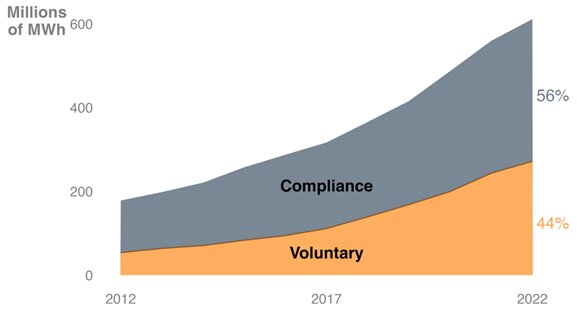U.S. Renewable Electricity Market
- How is the U.S. renewable electricity market organized?
- How do the mandatory and voluntary markets work together to grow U.S. renewable energy supply?
- How do Renewable Energy Certificate (REC) prices vary across voluntary and mandatory renewable energy markets?
How is the U.S. renewable electricity market organized?
The U.S. renewable electricity market is comprised of two types of buyers: those who are required to purchase renewable electricity and those who voluntarily purchase it. Regardless of whether or not you are required to purchase renewable electricity, buyers generally want to make a claim, or publicly state or disclose that they are purchasing or using renewable energy.
Mandatory/compliance markets exist because of policy decisions, such as state renewable portfolio standards (RPSs). RPSs require obligated electric service providers to have a minimum amount of renewable energy in their electricity supply. These policy decisions often specify eligible energy resources or technologies and describe how electricity service providers must comply. In these markets, policymakers may often consider criteria other than environmental attributes (e.g., economic or jobs growth) in setting mandatory market resource and technology eligibility criteria. Electricity service providers use renewable energy certificates (RECs) to demonstrate compliance with mandated renewable energy requirements.
Voluntary markets, also referred to as “green power markets,” are driven by consumer demand for certain types of renewable energy. Voluntary markets allow a consumer to procure renewable electricity at levels above and beyond what mandatory policy decisions require and to reduce the environmental impact of their electricity use. Voluntary green power products must offer a significant benefit and value to buyers to be successful.
How do the mandatory and voluntary markets work together to grow U.S. renewable energy supply?

It can be helpful to think of the mandatory market as a natural floor to the market, representing what is the basic minimum percentage of renewable energy provided to users. The voluntary market theoretically represents an unlimited opportunity above this market floor that is only constrained by voluntary demand and capped by total demand for electricity.
In order to ensure that both markets work together to increase supply, it is important that the voluntary market is separate from and incremental to the mandatory market. A purchase made by an individual or organization in the voluntary market must be incremental to any renewable generation claimed under the mandatory market. This concept is often referred to as “regulatory surplus” and helps ensure that double claims are avoided on the same megawatt-hour (MWh) of renewable energy generation.
How do Renewable Energy Certificate (REC) prices vary across voluntary and mandatory markets?
Differences in REC prices are a function of many factors, including the impacts of supply and demand, whether or not the REC is eligible under a State’s RPS, location of consumer, size of purchase, consumer preferences in resource types, etc.
The voluntary market operates on a supply-and-demand balance, with REC prices correlated to the amount a voluntary buyer is willing to pay for a product, relative to the available supply of that product.
In contrast, regulatory bodies tend to interject market price distortion into mandatory markets by setting targets and penalties (e.g., alternative compliance payments) that regulated entities (e.g., utilities) must pay in the absence of meeting the regulatory mandate. In some cases, these regulatory targets and associated penalties are resource specific, as is often the case for solar. As a consequence, renewable developers supplying the mandatory market not only know how much supply a regulated entity must buy, but also how much they are willing to pay in order to avoid the penalty of the alternative compliance payment. State policy-driven markets are also often supply constrained due to geographical and resource limitations. Therefore, pricing of RECs that supply mandatory markets tends to hover just below the alternative compliance payment cost for that market.
The following graphic shows the voluntary unbundled REC prices from 2014 to 2018. Voluntary REC prices increased from $0.31/MWh in August 2017 to $0.70/MWh in August 2018. These graphics should be viewed as illustrative, as pricing in markets can change over time.

